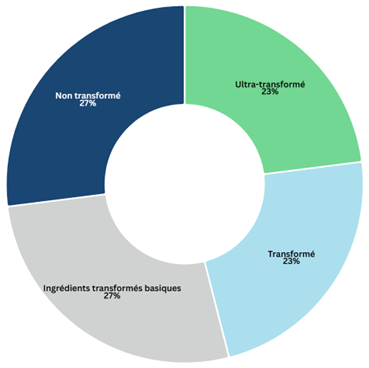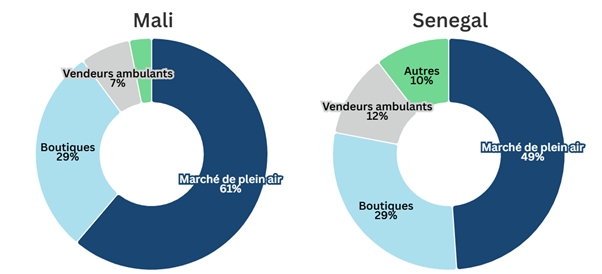Diets in West Africa: Diversification, Urbanization and Nutritional Challenges
Food consumption in West Africa has undergone profound transformations in recent years, such as the decline in self-production, greater reliance on the market, the growth of processed products and the multiplication of supply points. Based on a variety of data, including household surveys and studies conducted in several countries in the region, the Sahel and West Africa Club (SWAC/OECD) recently published a study which takes stock of the subject [1].
The FARM Foundation discussed the future outlook for food regimes in the region with two of its authors from the Sahel and West Africa Club, Jill Bouscarat (junior policy analyst) and Alban Mas Aparisi (economist and associate researcher at the Africas in the World laboratory at Sciences Po Bordeaux).

Copyright (c) 2025 Tolu Owoeye
FARM Foundation: How can we characterize diets in West Africa today? What are the major changes compared to the 2010s in the different countries of the region?
Alban Mas Aparisi : We have observed three major developments in food systems in West Africa over the past two decades.
First of all, a monetization of dietsAt the heart of the transformation of diets in the region is a growing presence of the market at the expense of self-production in household supply. In 2000, nearly two-thirds of West Africa's population lived in rural areasThis rural predominance is a thing of the past: more than one in two inhabitants now live in urban areas, a trend that will strengthen in the years to come. For its food, this urban population obtains its supplies almost exclusively through the market. The regional share of the workforce employed in agriculture has thus increased from 57 to 42 % in 20 years – in some countries like Senegal or Ghana, it has fallen to 30 %.
Even in rural areas, the role of the market has increased considerably. The increase in non-agricultural employment in rural areas is accompanied by a decline in self-production in household consumption. Products that were once emblematic of self-consumption, such as sorghum or millet, are now mainly purchased on the market.
The monetization of food is accompanied by a second trend: structural diversification of consumption, both in terms of products and their degree of processing. Thanks to commoditization, consumption becomes an economic opportunity and supply chains are expanding to national, regional and global scales, bringing a wider range of products to the market.
This dynamic also concerns the degree of processing. The share of processed and ultra-processed products is growing sharply. This trend reflects trade-offs linked to urbanization: with higher incomes and increased travel times, urban households—especially women, who are mostly responsible for shopping and cooking—are seeking to reduce the time spent preparing meals.
Average share of food consumed in Mali, Nigeria and Senegal, by degree of processing (%)

Source: SWAC/OECD, 2024
This transformation involves both risks and opportunities. The main risk concerns public health, with the negative nutritional effects of certain ultra-processed products. The major opportunity lies in the development of a regional agri-food economy (https://agra.org/wp-content/uploads/2020/09/AASR-2020-Feeding-African-Cities.pdf), around transformable local products with high added value, such as cassava flour. We are also seeing an increase in the quality of logistics and infrastructure, particularly for fresh products (vegetables, fruits, milk). This " hidden intermediate level » between producers and consumers – processing, logistics, catering – is developing rapidly, generating large-scale jobs and income for the region.
A third trend, linked to the two previous ones, is the diversification of places where food is consumed and purchased. Open-air markets are less central as places of access to food in West Africa. If the "supermarket revolution" observed elsewhere on the continent remains marginal in the region, we observe an increased importance of kiosks and street vendors, particularly in urban areas. Furthermore, a growing share of consumption now takes place through eating out, particularly at lunchtime, with the increase in home-work distances.
FARM: Does the diversification of diets you are talking about mean an improvement in the nutritional quality of the diet?
Jill Bouscarat : Not necessarily. Certainly, the diversification of diets in West Africa is accompanied by certain positive developments in nutritional qualityIn many countries, such as Mali, there has been a marked increase in the consumption of fruits and vegetables, for example. In four years, the frequency of fruit consumption has doubled, and that of vegetables has increased from four to five days a week. While there has been an increase in the consumption of certain foods associated with better nutritional quality, this trend is also accompanied by a marked increase in the consumption of foods rich in fat, sugar, or other processed foods.
The share of processed and ultra-processed products is growing rapidly in the region. In 2019, these products accounted for nearly half of the food consumed each week by households in Mali, Nigeria, and Senegal. Not all processed products are necessarily associated with poor diets, such as flour or dried tomatoes. However, ultra-processed products often are, raising real concerns about the nutritional quality of diets. Economic openness and urban lifestyles are profoundly transforming eating habits, with a growing influence of food giants (Coca-Cola, Kentucky Fried Chicken) on food preferences, often at the expense of a healthy diet.
These dynamics are part of a broader context marked by the “triple burden” of malnutrition – where undernourishment, nutritional deficiencies and overnutrition coexist. In 2021, more than 58 million people were underweight in the region, while about 52 million were overweight or obese. Obesity is growing rapidly in cities, as is the proportion of overweight people: 1/3 of the urban adult population in West Africa is overweight, and 12% is obese.In Ghana, obesity rates are reaching worrying levels, with half of urban adults estimated to be overweight, including 20% obese.
These figures highlight the need to refocus the research agenda and regional food policies around the issue of healthy eating, particularly by looking at the food problems in cities.
Affordability — that is, the relationship between the price of food products, income and the purchasing power of households — constitutes one of the main obstacles to the adoption of healthy diets. The poorest households struggle to access nutrient-dense foods, which remain relatively expensive compared to staple foods such as grains and starchy roots. Dietary diversification does not benefit everyone equally. For a large part of the West African population, healthy food remains economically inaccessible.
Whether it is physical access to products, promotional strategies, food marketing or information, all these factors, which constitute the food environment [2], strongly influence the transformations of consumption habits in the region.
FARM: What share of income is allocated to food in West Africa today?
Jill Bouscarat : In West Africa, households spend on average 55 % of their income on food, with variations depending on the country: 56 % in Mali, 65 % in Nigeria and 49 % in Senegal. Even the wealthiest households allocate between 42 % and 60 % of their income for food. This shows thecrucial importance of food expenditure in the daily lives of populations in West Africa.
This makes households particularly vulnerable to food price volatility; a slight increase can have significant consequences, particularly on the consumption of nutritious foods, which are often the most expensive. This consumption will be reduced first by households, with sometimes irreversible negative effects, particularly for infant nutrition. Structurally, the dynamic of high inflation in food products that began at the turn of the 2020s now constitutes one of the primary sources of food and nutritional insecurity in the region, beyond the mere questions of availability.
FARM: Where do households get their supplies today? What is the role of out-of-home catering?
Jill Bouscarat Urbanization, income growth, and changing lifestyles have significantly influenced people's eating habits and food supply in the region. Households now rely heavily on the market for food. In major cities, more than 90% of food is purchased in markets.
While open-air markets remain essential, consumers today source their supplies from a wide variety of outlets: street vendors, kiosks, stores, supermarkets. While cities are expanding and mobility inequalities are increasing, and therefore access to large open-air markets, are increasing, small points of sale are forming an increasingly central urban network. This differentiation is important because there is a segmentation of the food supply according to points of sale. Open-air markets still represent a majority source for certain basic products such as tubers and vegetables, while other products such as dairy products, eggs and sweets are mainly purchased in stores. Street vendors play an important role in the supply of fruit, while other points of sale complement this offer.
Share of food purchased in Mali and Senegal, by type of point of sale (%)

Source: SWAC/OECD, 2024
Eating out is gradually becoming more common, particularly in urban areas. In 2018-2019, one-third of households in Mali, Nigeria, and Senegal reported that at least one household member had eaten lunch outside the home during the week. This trend reflects a shift in lifestyles, with a search for convenience and greater exposure to a variety of food options.
FARM: What about rural areas? Are they also affected by these changes in practices?
Alban Mas Aparisi : The data show that these transformations affect rural areas as much as urban areas, even if their intensity is generally less.
First, market dependence remains lower in rural areas, but it is already very significant. Around 50,000 million people's food is purchased there. This trend is confirmed in Mali, Nigeria, and Senegal, where between one-third and two-thirds of cereal consumption, traditionally grown for self-consumption, such as millet or sorghum, now comes from purchases.
Second, we are also seeing a diversification of diets in rural areas. In Mali, for example, the average number of food groups consumed has increased from 8 to 9.4 in ten years. This means that consumers are increasing the diversity of products they consume. However, this diversification remains less marked than in cities, particularly with regard to products with high nutritional value such as fruits, vegetables, and animal products—a difference likely linked to lower income levels in rural areas. On the other hand, the consumption of processed and ultra-processed products is increasing uniformly: in Mali and Senegal, their share of the diet is now almost equivalent in urban and rural areas.
Finally, eating out is also expanding in rural areas. Nearly a third of rural households in Mali, Nigeria, and Senegal eat lunch outside at least once a week—a figure similar to that in urban areas (40,000 to 1,300)—and between 8,000 and 17,000 eat dinner outside the home. Including snacks and drinks, nearly three-quarters of rural households in these countries eat outside the home each week.
[1] The note Transformation of diets and food environments in the Sahel and West Africa was published by the SWAC/OECD and produced by Véronique Theriault (Michigan State University), Jill Bouscarat (SWAC/OECD), Alban Mas Aparisi (SWAC/OECD), Philipp Heinrigs (SWAC/OECD) and Amidou Assima (Michigan State University).
[2] In this study, we define the food environment as consisting of four dimensions: physical access; economic accessibility; promotion, advertising and information; and food quality/safety, see HLPE 2017 report.
Read the English version : https://fondation-farm.org/diets-in-west-africa-diversification-urbanization-and-nutritional-challenges/
